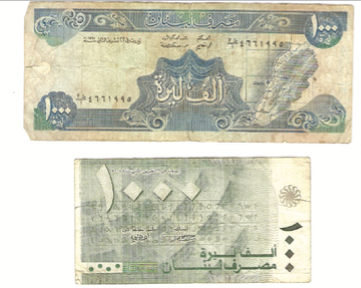The recent sociopolitical developments in Lebanon have created a mood for change and a hope for renewal. This is true for the political as well as economic future of the country. Indeed, the economy is in need of fresh air. A new Lebanese lira could stimulate the economy and fulfill positive expectations as a new symbol of societal trust and value creation.
Today, the Lebanese use liras for small transactions, like buying vegetables, and use US dollars for large transactions, like buying and selling their own land. A close look at dollarization levels reveals some interesting yet very worrisome facts. Lebanon is a partially dollarized economy. The simplest dollarization measure is the ratio of deposit dollarization. Deposit dollarization is calculated as the share of total deposits in foreign currency (FC deposits/Total deposits). This ratio was 70% in early 2005. The ratio increased immediately after the assassination of former Prime Minister Rafiq Hariri, and it now stands around 74%.
Deposit dollarization in Lebanon reveals the extent to which the lira, or the Lebanese Pound (LBP) as it is referred to today, is a marginal currency within the country. Theoretically and empirically, the reasons behind dollarization (partial or full) are linked to credibility issues. Indeed, high inflation rates and macroeconomic mismanagement have been considered the root cause of dollarization, which is a mechanism through which households and businesses protect their wealth from domestic instability. Lebanon’s case is not different. High inflation, currency collapse, and overall instability during the war years triggered deposit dollarization in Lebanon. However, inflation has been tamed since the mid-1990s and the exchange rate has been pegged to the dollar. And yet, dollarization rates are still very high.
Persistently high rates of dollarization to date can be explained by a number of reasons. Previous research suggests that there are high costs associated with financial adaptation. As such, de-dollarization is much harder to achieve. There are other reasons explaining the persistently high levels of dollarization in Lebanon. Some of the most important factors are: 1) the fact that the end of the war did not imply true and complete independence, 2) the gap between an open market philosophy and an unfree and co-opted post-war state; 3) high lira interest rates which made dollar loans more attractive given a fixed exchange rate, and last, but not least, 4) the design, colors, and name of the Lebanese ‘lira’.
Hope in the new lira
While exploring these factors further is crucial in understanding the current political economy of dollarization, suffice it to say here that the recent sociopolitical developments in the country give hope of a possible transformation in the near future. Indeed, Lebanon might be faced with a once in a lifetime opportunity to set things right. The issuing of a new lira could do justice to the recent changes in the political agenda. A new lira could be the result and midwife of a strengthened Lebanese consensus. It could give the state structures, the political elites, and the people the right incentives to pursue the path of healing and institutional reform.
A new lira could mobilize the necessary levels of trust if it is made, de jure and de facto, the sole legal tender within all regions and sectors of Lebanon. While the benefits of a new lira could be significant in creating the proper incentives for all involved parties, i.e. the state, the people, and the political elites, it cannot succeed as a strategy if real and serious institutional reforms are not implemented. In other words, without fundamental institutional reforms, issuing a new currency would typically be a theatrical performance with no real economic value, a simple paper change. The success and effectiveness of a new lira depends on the harmonious interaction and co-operation of elites, people, governments, institutions, and last but not least banks. Moreover, it will most certainly require rational policy making and a great leap of faith.
While institutional reforms are a necessary condition for the success of a new lira, they do not necessarily need to precede the introduction of a new lira. Indeed, a new lira could be the very incentive that would bring together the many different factions of Lebanon, in the pursuit and implementation of necessary reforms.
The new lira must be the only currency accepted inside Lebanon, and it must also be freely exchangeable with any other currency at a market price. While the exchange rate policy associated with the new lira is a subject of discussion in its own right, introducing a new currency could kick off the economic machine through a renewal of trust and give Lebanon a fresh start. The new lira must reflect Lebanon’s sense of self as it stands — a multicultural, multiethnic, multi-faith, free and creative psyche.
Trust in a currency comes from many different types of sources; some are pure economic and rational, others are emotional and irrational. As such, the physical appearance of the new lira is crucial. Its size and color must be attractive, serious, and meaningful. Finally, the new lira should be a lira and not a pound. All banknotes and coins issued by the Central Bank of Lebanon since 1964 have the title ‘lira’, and yet the Lebanese financial and economic authorities have opted for the name ‘pound’ throughout the last decade. Although a translation, there seems to have been a ‘self- denial’ in the very name of the Lebanese currency.
Making sure the new lira is not a paper tiger
With all this taken into account, if the use of the new lira is not compulsory across regions and sectors, the change would be purely a paper change and would not have any serious impact on the issues at hand. Moreover, if such a project is taken on, the value of the new lira and the denominations to be used can only be the outcome of an in-depth economic reappraisal. The possible effects of a new lira and its obligatory use across all sectors and regions of Lebanon are many. Any Lebanese asset, whether tangible or intangible, will have to be exchanged in the new lira. Enforcing such a policy across all sectors will create enough demand for the lira to allow for a freer floating rate. Although, a fixed exchange rate could still be maintained until the right policy environment is created.
A new lira enforced across the country will create the missing macroeconomic space. Moreover, a trustworthy lira with a widespread use will free local investment decisions from the much required US dollar, and reclaim the seignorage revenue that is currently directed toward the Federal Reserve. Ultimately, monetary policy will be more effective and fruitful.
Theoretically, enforcing the use of the current lira would also have the same positive effects. In reality, however, the last decade has shown that the current LBP has not been able to reclaim its due place as the sole medium of exchange in Lebanon. Moreover, mobilizing the trust of the Lebanese people in the current LBP might not be possible on the symbolic level.
Also, the recent sociopolitical transformations and the intention of giving birth to new state structures deserve to be translated into the economic realm and a new lira could do justice to the envisaged rebirth of Lebanon. Moreover, the LBP banknotes currently in circulation reflect a serious confusion. Today, one can find a 5000 LBP note in different sizes, two different types of 1000 LBP notes, different sizes of other denomination notes, and so on.
It is important to introduce trust and confidence in the paper, by standardizing it and reorganizing its physical features. Moreover, a new lira could be an opportunity to cement the recent consensus through symbolic representations that would support and promote the key values and historic contributions of different segments in Lebanon.
States and governments can distribute wealth, and they can also distribute poverty. However, they cannot manage the economic game of a nation if citizens choose not to play. While governments must assume responsibility, the Lebanese people must choose to be proactive and determined to reap the benefits of mutual trust. The road ahead is determined by implemented policies.
The choice and the future is Lebanon’s. While choosing, the Lebanese have to keep in mind that the best they could ever be to the US economy is a non-voting province, whereas a new lira can open the gates of locally created and managed prosperity.
Armen V. Papazian is a senior vice president of market development at the Dubai International Financial Exchange










